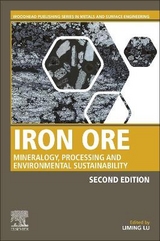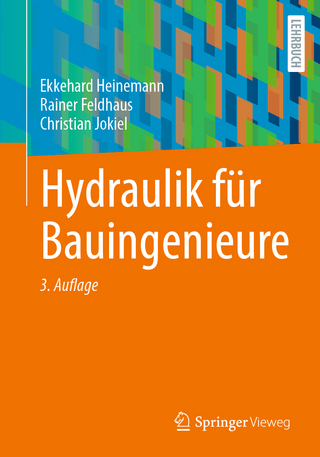
Iron Ore
Woodhead Publishing Ltd (Verlag)
978-1-78242-156-6 (ISBN)
- Titel erscheint in neuer Auflage
- Artikel merken
The text is an ideal reference on the topic during a time when iron ore production has increased significantly, driven by increasing demand from countries such as India and China.
Dr Liming Lu is currently a Senior Principal Scientist leading CSIRO research and development in iron ore agglomeration and high temperature behaviour of resultant agglomerates during the blast furnace and other alternative ironmaking processes. Liming has more than 28 years R and D experience in the characterisation, processing and evaluation of iron ores, metallurgical coals and molten alloys. He has published 10 book chapters and more than 130 papers including 6 invited review. He is a Technical Expert of ISO Technical Committee TC102/SC3, which is reviewing and developing international standards for the physical testing of iron ore. Liming has served as a Key Reader for Metallurgical and Materials Transactions A, a member of the Editorial Board for Ironmaking and Steelmaking and a member of the Advisory Board of ISIJ International. Liming was the recipient of Josef S Kapitan Award from American Iron and Steel Society in 2003 and Sawamura Award from the Iron and Steel Institute of Japan in 2018. He was appointed as an Adjunct Professor by Central South University, Kunming University of Science and Technology, Liaoning University of Science and Technology and Shanghai University in China.
List of Contributors
Preface
1: Introduction: overview of the global iron ore industry
Abstract
1.1 Introduction
1.2 Iron ore mining operations by country
1.3 Technology status and challenges
1.4 Iron ore outlook
Part One: Characterization and analysis of iron ore
2: Mineralogical, chemical, and physical characteristics of iron ore
Abstract
2.1 Introduction
2.2 Mineralogy
2.3 Chemical composition
2.4 Physical properties
2.5 Future trends
3: XRD analysis and evaluation of iron ores and sinters
Abstract
3.1 Introduction
3.2 Principles of powder X-ray diffraction
3.3 Rietveld analysis
3.4 Sources of error in XRD analysis
3.5 Applications of cluster analysis
3.6 Applicability of XRD analysis
3.7 Use of mass balancing in iron ore analysis
3.8 The principal minerals and phases
3.9 XRD for the characterization of Iron ores
3.10 XRD in sintering and pelletizing
3.11 Summary and conclusions
4: Automated optical image analysis of natural and sintered iron ore
Abstract
4.1 Introduction: Overview of optical image analysis technique
4.2 Mineralogical characteristics of iron ore and sinter
4.3 Automated optical image analysis (OIA)
4.4 Application of automated OIA to natural and sintered iron ore
5: Quantitative analysis of iron ore using SEM-based technologies
Abstract
5.1 Introduction
5.2 Principles of SEM-based technologies
5.3 Application of automated SEM-based technologies to ore characterization
5.4 Characterization of natural and sintered iron ore using QEMSCAN
5.5 Summary
5.6 Future trends
6: Characterization of iron ore by visible and infrared reflectance and, Raman spectroscopies
Abstract
6.1 Introduction
6.2 Principles of reflectance and Raman spectroscopies
6.3 Technologies
6.4 Reflectance and Raman spectroscopies of iron ore minerals
6.5 Future trends
Part Two: Extraction, comminution, separation, and beneficiation of iron ore
7: Iron ore extraction techniques
Abstract
7.1 Introduction
7.2 Iron ore mining—an historical UK context
7.3 Underground iron ore mining: Kiruna, Sweden
7.4 Modern-day surface mining: the Pilbara deposit
7.5 Modern day surface mining: iron ore in Minas Gerais Province, Brazil
7.6 Conclusions
8: Developments in iron ore comminution and classification technologies
Abstract
8.1 Introduction
8.2 Iron ore crushing and screening
8.3 Iron ore grinding and classification
8.4 Future trends in iron ore comminution and classification
9: Developments in the physical separation of iron ore: magnetic separation
Abstract
9.1 Introduction
9.2 Principle of magnetic separation
9.3 Magnetic separators
9.4 Typical flow sheets for iron ore separation
9.5 Challenges and recent advances in magnetic separation
9.6 Summary
10: Developments in nonmagnetic physical separation technologies for hematitic/goethitic iron ore
Abstract
10.1 Physical processing for enhanced chemical and/or physical properties
10.2 Dense medium separation
10.3 Jigging
10.4 Upflow classification
10.5 Spiraling for iron ore beneficiation
11: Developments in the physiochemical separation of iron ore
Abstract
11.1 Introduction
11.2 Mineral properties
11.3 Iron ore flotation
11.4 Key challenges and future directions
12: Developments in chemical separation of iron ore
Abstract
12.1 Introduction
12.2 Phosphorus removal
12.3 Removal of silicon, aluminum, and sulfur minerals
12.4 Summary and future trends
13: Application of biotechnology in iron ore beneficiation
Abstract
Acknowledgments
13.1 Introduction
13.2 Microbial adhesion to mineral surfaces
13.3 Bioleaching for phosphorus removal from iron ores
13.4 Biobeneficiation of sulfide ores
13.5 Biobeneficiation of iron ore
13.6 Future trends
Part Three: Iron ore agglomeration processes and blast furnace iron-making technology
14: Iron ore sintering
Abstract
Acknowledgments
14.1 Introduction
14.2 Effect of iron ore characteristics on sintering
14.3 Evaluation of iron ore for the sintering process
14.4 Recent developments in iron ore sintering
14.5 Conclusions
15: Iron ore pelletization
Abstract
15.1 Introduction
15.2 Specification requirements of pellet feed
15.3 Green ball formation and properties
15.4 Induration of green pellets
15.5 Quality requirements for fired pellets
15.6 Conclusions
16: Quality requirements of iron ore for iron production
Abstract
Acknowledgments
16.1 Introduction to ironmaking technologies
16.2 Quality requirements of iron ore for the BF ironmaking process
16.3 Quality requirements of iron ore for alternative ironmaking processes
16.4 Summary
17: Recent developments in blast furnace iron-making technology
Abstract
17.1 Introduction
17.2 Blast furnace design and facilities
17.3 Blast furnace process
17.4 Key innovations and future trends
Part Four: Environmental issues and low emission technologies
18: Sintering emissions and their mitigation technologies
Abstract
18.1 Introduction
18.2 CO2 emissions and their mitigation
18.3 SOx emissions and their mitigation
18.4 NOx emissions and their mitigation technologies
18.5 Dioxin emissions and their mitigation
18.6 Dust emissions and their reduction
18.7 Utilization of biomass materials in iron ore sintering
18.8 Conclusions
19: Utilization of biomass as an alternative fuel in ironmaking
Abstract
19.1 Introduction
19.2 Potential applications of biomass-derived materials and impact on net GHG emissions
19.3 Physical and chemical properties of biomass-derived chars to optimize ironmaking operations
19.4 Economic sources of biomass fuel
19.5 Pyrolysis of biomass for ironmaking applications
19.6 Applications in ironmaking
19.7 Future trends
19.8 Sources of further information and advice
20: Life cycle assessment of iron ore mining and processing
Abstract
20.1 Introduction
20.2 Iron ore mining and processing
20.3 Application of LCA to iron ore mining and processing
20.4 Using LCA to reduce energy and GHG impacts
20.5 Conclusions
20.6 Sources of further information and advice
Index
| Verlagsort | Cambridge |
|---|---|
| Sprache | englisch |
| Maße | 152 x 229 mm |
| Gewicht | 820 g |
| Themenwelt | Naturwissenschaften ► Biologie ► Ökologie / Naturschutz |
| Technik | |
| ISBN-10 | 1-78242-156-4 / 1782421564 |
| ISBN-13 | 978-1-78242-156-6 / 9781782421566 |
| Zustand | Neuware |
| Informationen gemäß Produktsicherheitsverordnung (GPSR) | |
| Haben Sie eine Frage zum Produkt? |
aus dem Bereich



